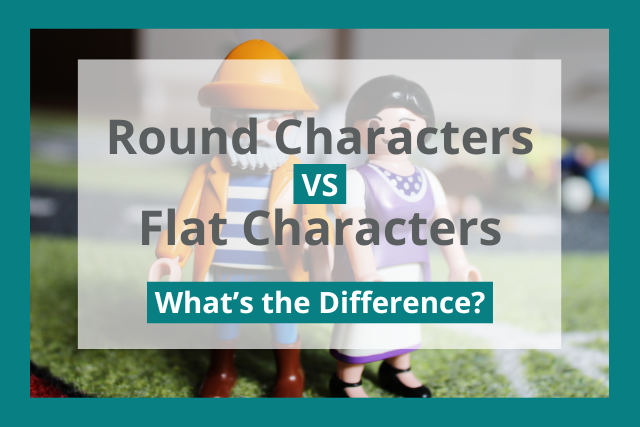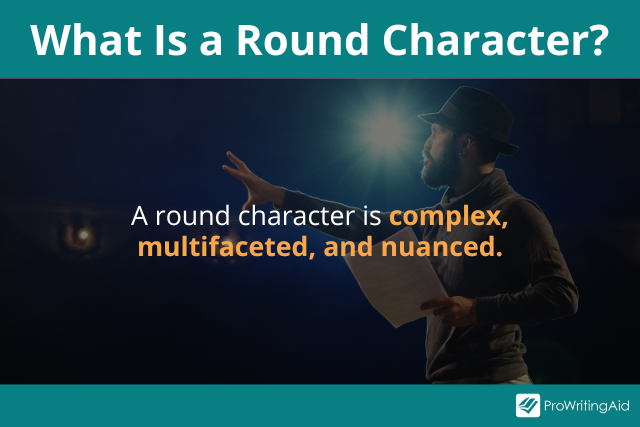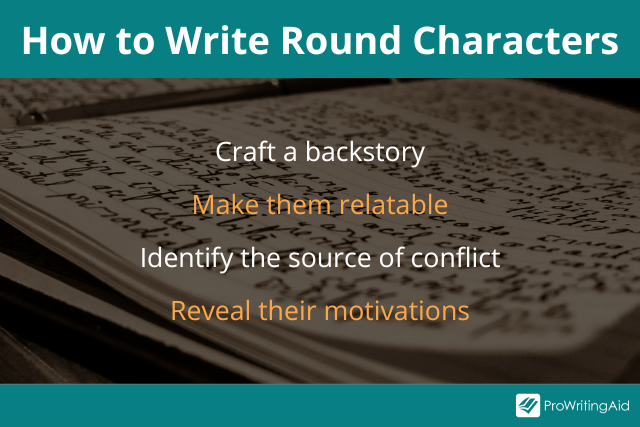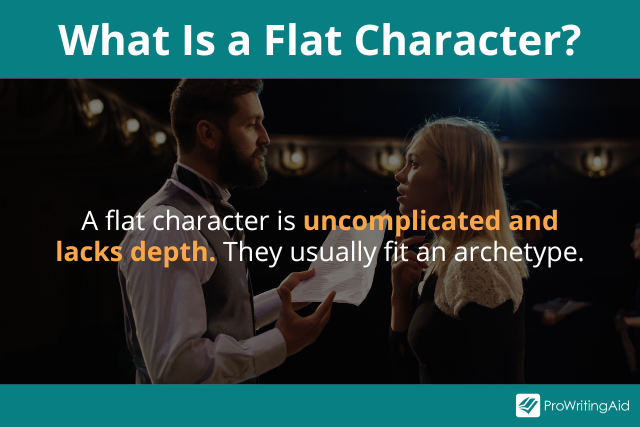
All of your favorite fictional characters fall into one of two categories: flat or round.
Round characters are characters who are complex, multifaceted, and have a layered personality. Flat characters, on the other hand, fit an archetype, are unchanging, and are uncomplicated. Both character types help to create a compelling story when used effectively.
In this article, we’ll look at the distinction between flat and round characters, how to identify them, and how to write them in your own stories.
Round Character Definition and Meaning
A round character is a layered and complex character in a story. They face difficult decisions, have desires, motivations, relatable traits, and even flaws.
Round characters are well developed and tend to undergo personal growth throughout their story.
Because round characters possess so many dimensions, they appear human-like. As readers gain more insight into the characters’ personalities and lives, they are able to relate, and are more likely to become invested in the characters’ stories.

Examples of Round Characters in Literature
Round characters are found in every creative work. A good round character will appear real to the readers, making the story more compelling.
Let’s look at a few examples of round characters in famous literary works.
Severus Snape from Harry Potter
When readers are first introduced to Severus Snape, he is the stereotypical villain. He appears cold and constantly mistreats the main protagonist, Harry Potter.
Throughout the story, we get glimpses into his inner conflict. His actions are unpredictable, which leaves readers guessing what his motivations are and where his loyalty lies.
By the end of the book, his true nature and allegiances are shown, which reveals the complexity of his character.
Jay Gatsby from The Great Gatsby
Jay Gatsby appears as a wealthy man who is as eccentric as he is enigmatic. He throws lavish parties, which are attended by almost everyone.
At first, he seems like the stereotypical rich elite, but later on readers see his history and complex nature.
Gatsby grew up poor, but has evolved into a man of esteem and mystery. His motivation to throw extravagant parties lie in trying to get the attention of Daisy.
This also happens to be his fatal flaw, as he goes from being a wealthy, seemingly adored man to deceased with few attending his funeral.
Tips for Writing Round Characters
As you create your own characters for your stories, there are some best practices to follow.
Here are some tips on how to create your own round characters.

Craft a Backstory
Whether your character is the hero or anti-hero, readers want to know where they’re from and what their story is.
Some books follow the character from birth, so readers don’t need a backstory. In other cases, where we’re introduced in the middle of the characters’ lives, we’ll need to be caught up.
When crafting a back story, think of the character’s family history. Perhaps it was tumultuous and didn’t give much room for autonomy or creativity. Perhaps the character grew up poor and now resides in a wealthy neighborhood but experiences survivors’ guilt.
By developing the character’s backstory, the reader will better understand their traumas, flaws, goals, and fears.
To develop a good backstory you can delve into the character’s history, education, social and economic status, and even provide insights into their family and friends.
Make Them Relatable
Round characters are inherently human, so they must be relatable to your readers. To do this, add relatable traits such as speech patterns, the way they dress, and their personality traits.
A part of being human is that no one is perfect. That applies to round characters as well. Flaws and contradictions, such as endearing shortcomings, make them relatable and can trigger an emotional response in your readers.
For example, your character can be full of pride or headstrong. Or your character’s actions and decisions can be unpredictable throughout the story.
Conflict Is Essential
Whether the conflict is external or internal, there must be some amount of struggle to move the story forward.
In reality, no one has a perfect life, which should be the case of your round character as well. There must be an obstacle for the character to overcome, which will form the plot of the story by revealing what is at stake.
Conflicts can reveal qualities of your character based on their choices. An internal conflict can be their own flaws and philosophies, while external conflicts can be their dynamic with another character.
Reveal the Character’s Motivations or Desires
There must be a driving force that moves the character to act.
Look at what motivates your character. What are their goals, what are they passionate about, and what are they afraid of? This will help to frame and contextualize the decisions they make and the conflicts they face.
The character’s desires can be psychological, emotional, or physical. As the story moves along, a character's actions become more believable if there is a desire to contextualize it.
Flat Character Definition and Meaning
Unlike round characters, flat characters are not complex. They lack depth and can easily be placed into a stereotype.
There isn’t much to their backstory, and they don’t evolve over the course of the story. They’re straightforward, easy to figure out, and serve a limited purpose in the story—to drive the plot forward.
That doesn’t mean they aren’t important to your story. They can have supporting roles and assist in the round character’s development, or they can simply fulfill certain archetypes.
For example, the mean stepmother, a dumb henchmen, and the funny sidekick are all common tropes for flat characters.
Flat characters are sometimes confused with static characters. Static Characters also don’t change over the course of a story but they have a more layered and complex personality than a flat character.

Examples of Flat Characters in Literature
Flat characters can be found in all your favorite stories.
Here are some examples of flat characters who effectively advance the plots of their respective stories.
Crabbe and Goyle in Harry Potter
Crabbe and Goyle are sidekicks for Draco Malfoy. They’re presented as simple characters with no underlying motivation or purpose other than to do Draco’s bidding.
We don’t know anything about their backstory, nor do they change at any point during the story. They do, however, support Draco’s actions and act as reflectors that highlight the complexities of Draco’s personality and conflicts.
Mr. Collins in Pride and Prejudice
Mr. Collins is vain, egocentric, and pompous. He represents the stereotype of the wealthy class of British Society, whom Jane Austen despised.
While he remains the same throughout the story, Mr. Collins is the center of a key plot point that provides the opportunity for Elizabeth and Darcey to get together.
He also provides comedic relief and acts as an outlet for Austen to convey her views on British Society.
Tips for Writing Flat Characters
Flat characters can add value to your story. They can advance or complicate the plot, add comedic relief, or reinforce the qualities of your round characters.
Here are some tips on how to write flat characters effectively.
Determine Their Personality
A flat character is marked by their key defining trait. This can usually be encapsulated in one word: bully, jock, drama queen. Their personalities should be uncomplicated and easy to summarize.
For example, in classical Disney stories, the evil stepmother is evil and her actions reinforce this key characteristic.
Make Them Predictable
Flat characters follow a pattern based on their archetype, which makes them predictable. They don’t change throughout the story, and readers don’t expect them to change.
Clarify Their Purpose
Flat characters must be written to clearly show how they’re advancing the plot. For example, they can serve as the writer’s way to introduce comedy into a scene. This may mean they are often the butt of a joke or the one who always cracks jokes.
They can act as foils, which are polar opposites of the main characters. In this sense, they amplify the characteristics of the main characters through comparison.
Don’t Add Depth
You don’t want to confuse the readers by getting too involved in the story of the flat character. The readers will get bogged down with too many details and flat characters will end up being a distraction.
Bear in mind what you are trying to achieve in a particular scene, and don't get carried away with too many details.
For example, if your character is a school bully, there’s no need to mention background information or motivations.
Flat characters only need to be developed enough so the reader can understand the character’s relationship to the main characters.
Conclusion on Round vs Flat Characters
These points sum up the main differences between round vs flat character traits:
- Round characters have multifaceted personalities, while flat characters fit a particular stereotype
- Round characters will evolve throughout the story, while flat characters never experience any character development
- Readers are more likely to relate to round characters because they appear life-like; flat characters, on the other hand, aren’t meant to be taken seriously
Before you start writing, decide on which characters will have depth and which won’t. Both character types have their advantages and can elevate your story’s narrative structure when used correctly.

